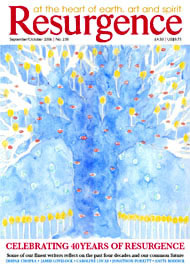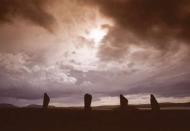IT'S BEAUTIFUL UP here, sitting on a plane staring at clouds. Or should I say, it's still beautiful? There are invisible dangers in the atmosphere. The toxic breath of industry, the careless debris of The Good Life being led down below. I know this, yet these white billows, rank upon rank, look so pure that for a moment one forgets.
Thirty-five years ago, on a long migration from India to America, I wasn't worried about the clouds getting dirty and poisoned. I wasn't worried about anything. That trip was all excitement and confidence. I had a new bride by my side and a job offer clutched in my hand. Every ambitious young man I knew back in Delhi was facing West, and when word got out that the Vietnam War had created a doctor shortage in the US, I couldn't wait to make the leap. I expected The Good Life to come my way, and it did. I expected The Good Life to make me happy, but it didn't.
I put in almost twenty years of effort to prove both things to myself. Camped out in a threadbare New Jersey motel that first night, I switched on a colour television for the first time in my life and saw a bloody victim of gangland violence being rushed to the hospital. Oh my God, they were taking him to the emergency room I would be working in tomorrow. In a sense those few ingredients - patients in need, colour TVs, and rushing from one hospital to the next - became hallmarks of my new existence.
But by 1980 I felt adrift, seeing myself as someone who knew everything about medicine and almost nothing about healing. After casting about aimlessly, I did something none of my Indian friends were doing: I turned my face East again. Not just out of personal restlessness. Not just to find God, because that wasn't my intent. I kept thinking about something else: why does the pursuit of happiness make us so unhappy? I had devoted myself to finding happiness, yet a looming, warning figure stood in my way.
That figure was the guru. Westerners glamorise gurus into spiritual superstars or demonise them as arrant charlatans. But in India a guru is more like your conscience. Strictly speaking, the Sanskrit word guru means dispeller of darkness, but in everyday life gurus are like a nagging inner voice reminding you that there are higher things to live for. Needless to say, gurus don't equate with The Good Life.
We are guilty in India of using gurus as spiritual anodynes, harmless as an English vicar but good for the soul. I decided to take them seriously, because for centuries the gurus have painted a clear picture: there are two ways to live - one is the pursuit of pleasure, the other is the pursuit of moksha, or liberation. The two roads sharply diverge, which is why The Good Life and gurus don't mix. I had proved to myself that pleasure, in and of itself, leads to exhaustion and inner deterioration. What could the guru offer instead?
I won't recap my years with Maharishi Mahesh Yogi, except to say that the impact of a guru was everything I had hoped for and more. I found inner discipline and silence, not as ends in themselves but as openings to a great, unknown subtle realm that permeates nature. Next, I came to trust in another face of the guru, known as upaguru, or the teacher who is close by. Upaguru can be anyone or anything; whatever experience brings a flash of insight, a small step towards liberation. I have sat in lonely hotel rooms in Paraguay or Dubai and idly turned on the television, only to have the next image on the screen bring a sudden epiphany.
ONCE YOU ARE committed to dispelling your own darkness, guru is everywhere. After thirty-five years on the path, this has proved the most valuable lesson. And now I believe it is the lesson humanity has to learn. Why is our planet on the verge of ecological catastrophe? Because everyone wants The Good Life. They want it in Khartoum as much as in midtown Manhattan. As long as The Good Life means sensual pleasure, the acquisition of cars, houses, planes, boats, vacations, jet skis, and so on, we are in peril.
Staring at the clouds today, I see guru. The message of the clouds is the same as the message of Vasishtha or Ramana Maharshi or any other true guru: See yourself anew. We will not save the planet so long as we see ourselves through old eyes. If humans are animals that insatiably crave pleasure, we are lost. But happiness can be defined by the other road, the pursuit of liberation. I will never be free as long as I am an isolated individual struggling against nature. Freedom comes from surrender, and the first surrender must be to nature itself.
Nature is a cloud. It has no boundaries. It is incredibly pure and beautiful. Its motions are unpredictable. Clouds are always here, yet they appear and disappear, seemingly at random, always in the service of life. To adopt such an existence for ourselves is possible. Humans have always been sky-watchers: we have identified with what lies beyond the clouds.
So the guru's choice remains as clear as ever. I don't imagine that anyone will buy prime-time ad space to declare that upaguru is the way of the future. But revolutions crop up unexpectedly (like clouds, once again), and I believe the present ecological crisis has its inner dimension. The next revolution, the one that will save us, will arise inside. When it does, humanity will experience itself in a new way, and when our descendants gaze at the clouds, still beautiful and pure, they will murmur to themselves, "Ah, it's true. I am that."
Deepak Chopra trained as a medical doctor and combines physical wellbeing with spiritual awakening. He is a prolific writer and lecturer. His latest book Peace Is The Way distils his political, social and ecological concerns. He is President of the Alliance for a New Humanity www.anhglobal.org.








